On a recent job at Discovery to do some analytics for Vitality, I was looking at data that is recorded into their platform as part of their insurance linked wellness program. There are various activities that are tracked as part of the program and a fair amount of it is running data. Given the size of their customer base it’s fair to assume that many of them have run the Comrades Marathon, and I wanted to see what all those runner’s various training programs looked like.
You can see a narrow version here (1024 wide) and a wider version here (1920 wide). Please be aware that this calculated and rendered using D3, it’s takes a while to load.
With Discovery’s permission I grabbed as set of anonymised data of recorded activities which included date and time, distance run, average speed and for some runners, their average heart rate. This was trimmed to anyone who had run at least one run greater than 80km to reduce it to Comrades only runners which resulted in a list of 1030 runners in total.
The visualisation is designed to compare the distance and speed between different runners on different days of the year, which makes it visually quite dense but allows for a quick visual comparison between runners.
Each row represents one runners data, for one year. Starting with the Comrades marathon on the 31 May 2015 and ending at the May 29 2016 Comrades marathon. At the end of the row you can see the runners calculated completion time and average heart rate (if it was reported) for the 2016 Comrades. Each column represents one day, showing the distance run (the vertical line) up to 90km and the speed of the run (the dot below it) ranging from 5 – 20km. The top row shows the median value per day across all runners and the rest of the rows are sorted according to finishing time for the race.
The colour scheme is based on solarized, which is quite commonly used for text editors. The reason for having 2 versions, wide and narrow, is mostly just the sheer number of elements. It has to render over 750,000 little SVG elements. Redrawing that takes a long time.
There were very few complications with the data. There were some split readings that had to be aggregated, sometimes the speed or distance was too fast / far to be realistic and had to be excluded or they didn’t actually run the Comrades this year. Also some of the rows don’t seem quite right. The very first runner seems a little inconsistent and their heart rate is low. Overall the data quality was great.
I was hoping to come find some easily discernible patterns that show how people train and that if you followed their regime you could do a better time. But there is nothing visually obvious here. Some people run far, some not, some people run almost every day, some just on weekends. There is also some data that’s missing. While some runs might not get recorded, the bigger issue is that some people either picked a hard New Year’s resolution, or they got a run tracker for Christmas and only started recording the data from 1 January 2016. The counts of the number of record runs increased after the New Year. You can also see which are the more popular training runs and specifically how many runners did the Two Oceans.






If we know the runners final race time, we can use regression to predict their next race performance based on applied training effort. And then offer individual incentives.
Hi Jacques! For sure. What is unknown at the moment is how accurate those predictions will be. It’s something I want to work on next as this is the sort of data set that lends itself well to machine learning.
Did you see the one dude who clearly made a New Year’s resolution, ran huge distances for a week, and then sat on the couch for two weeks either recovering or completely sick of running?
Ah yes, that dude. Its common enough that it should have its own syndrome name.